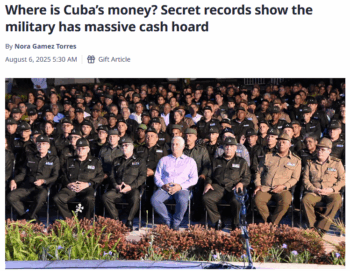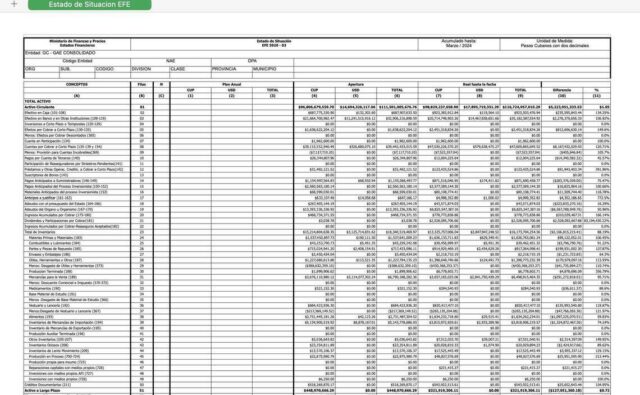This story was written in collaboration with Belly of the Beast, an independent outlet that covers Cuba and US/Cuba relations.

The Miami Herald‘s exposé (8/6/25) of the Cuban state enterprise GAESA appears to be based on a willful misreading of a financial document.
In an article published earlier this month, Miami Herald journalist Nora Gámez Torres (8/6/25) claims to have obtained a “trove of secret accounting documents” proving that Grupo de Administración Empresarial SA (GAESA), the conglomerate run by the Cuban military, has been stockpiling $18 billion dollars in cash while the Cuban people endure a devastating economic crisis.
The “wealth amassed by the Cuban military at the expense of the Cuban people is a secret no more,” proclaimed Gámez Torres. She added that GAESA is “squeezing the state out of the funds it could use to invest in healthcare, energy and food.” The documents, she wrote, demonstrate “that the Cuban government has been falsely blaming the US embargo as the sole cause of the island’s impoverishment.”
No credible evidence was presented to back up any of these sweeping claims.
As for the $18 billion dollars—it appears the Herald may have made an egregious error in interpreting the one “secret” document upon which the entire article appears to hinge. (For a deeper look into the numbers, and why we have more questions than answers about GAESA, check out Belly of the Beast’s interview with economist Emily Morris.)
This shaky, contextless reporting is par for the course for Gámez Torres, whose work has been repeatedly used by Secretary of State Marco Rubio and other Cuban-American hardliners to legitimize the US government’s economic war on Cuba.
Fuzzy math
Gámez Torres claims to have obtained 22 financial statements, but the Miami Herald published only one—a low-resolution screenshot of a balance sheet that shows all the assets under the control of GAESA’s companies. Gámez Torres asserted that the screenshot shows GAESA has assets of $18 billion in US dollars, $14.5 billion of which are in cash in readily accessible bank accounts. She went on to explain that this amount of monetary assets is larger than the reserves of Panama, Uruguay or Costa Rica.
There is one significant problem with this potentially bombshell discovery: It seems to be based on a conspicuous misreading of the one document the Herald published. The figures that carry the Herald’s argument can be found in Column 8, under the heading “USD.” (See the screenshot below). At the top of this column, in bold, total assets are listed as nearly $18 billion ($17,895,719,315.39), and two lines down, total assets in bank accounts appear as around $14.5 billion ($14,467,838,651.66).

The upper-right cell of GAESA’s spreadsheet reads “Unidad de Medida: Pesos Cubanos con dos decimos”—or “Unit of Measure: Cuban Pesos with two decimal places.” The Miami Herald ignored this straightforward explanation.
But the upper-right cell of the header of the spreadsheet states in plain language that the unit of currency for the financial statement is not US dollars, but “Cuban pesos with two decimal points.” This indicates that the figures under the USD heading have been converted from their original dollar value to a value in Cuban pesos. (The fact that the figures have a dollar sign in front of them is not determinative; that symbol is commonly used to denote Cuban pesos as well as US dollars.) Since the Cuban government generally calculates one US dollar to be worth 24 Cuban pesos, GAESA’s US dollar assets would be worth $745 million dollars (1/24 of 17.9 billion pesos)—or about 4% of the figure reported by the Herald.
There’s another reason to think that the Herald has greatly exaggerated the numbers in the screenshot. The spreadsheet adds the figures in Column 8, which the Herald claims are US dollar amounts, to the figures in Column 7, which are labeled “CUP”—the standard abbreviation for Cuban pesos. You don’t have to be a CPA to know that adding two different currencies with different values together without first converting one of them is an accounting no-no. The logical conclusion is that the columns labeled “USD” and “CUP” are in the same unit of measurement—and the header note indicates that that unit is Cuban pesos.
The Herald didn’t acknowledge the note in the spreadsheet’s header about all the numbers being in Cuban pesos, although it did speculate as to why GAESA would be adding dollars and pesos as if they had the same value: “to conceal its dollar holdings” from the rest of the government.
Gámez Torres did not indicate why she believes such a patently obvious mistake would deceive anyone, much less number-crunchers at Cuba’s tax authorities or its National Office of Statistics and Information. It’s also unclear why she thinks the government of Cuba wouldn’t notice a diversion of wealth equal to almost 50% of the nation’s GDP. (Cuba’s National Office of Statistics and Information calculated GDP in 2023 to be 869.2 billion Cuban pesos, which is $36.2 billion dollars at a 24:1 rate.)
It’s not clear whether Herald reporter Nora Gámez Torres is intentionally distorting GAESA’s accounting, committing an innocent blunder, or, for some reason, withholding information that led her to draw these seemingly baffling conclusions.
It might not matter, since her reporting aligns with the widely accepted narrative that Cuba’s military is profiting off the backs of the Cuban people. Far from being questioned for her lack of journalistic standards, Gámez Torres is winning prestigious awards and being showered with praise by Republican politicians from Florida.
The case for economic warfare
Gámez Torres has spent the better part of the last year reporting on GAESA. Last December, she reported on documents allegedly leaked from Gaviota, a tourism company under the GAESA umbrella that manages many hotels and resorts on the island. Although she did not disclose any documents, she claimed that the company and, by extension, the military were “sitting on about $4.3 billion.” She wrote that the Cuban military used GAESA companies to “divert” massive public funds to the country’s military-run companies while ordinary Cubans face food, medicine and fuel crises.
Gámez Torres has since earned accolades from pro-embargo politicians, who use factoids from her reporting to push for ever-harsher sanctions on Cuba. In turn, she regularly quotes them in the Miami Herald.
In an article about GAESA earlier this year (3/4/25), Gámez Torres quoted Cuban-American Rep. Mario Díaz-Balart (R-Fla.), who gushed over her “skill, determination and well-cultivated sources.” Díaz-Balart praised her reporting as “essential to policymakers and the American people to strengthen our national security.”
Gámez Torres’ latest article on GAESA provides another example of this echo chamber: She cites Rubio citing…herself.
She also quotes a State Department official who references her dubious reporting to justify sanctions:
Evidence of secret dollar reserves held by GAESA, while the Cuban people lack basic needs, serves as further evidence that President Trump’s actions to strengthen the US policy towards the Cuban people was of the utmost importance.
This policy, which amounts to economic warfare, has had disastrous consequences for the Cuban people.
Trump’s “maximum pressure” sanctions, which he imposed during his first term and were largely kept in place by Biden, have sought to bring about regime change by destroying the island’s economy. Over the last eight years, the sanctions have taken a toll, causing scarcities of fuel and medicine and driving unprecedented numbers of migrants to the United States.
As much as the Herald reports on Cuba, it has done almost no reporting on the impact of sanctions on the Cuban people. Nor has it shown any interest in looking into the millions of dollars flowing through Miami to the pro-embargo activists, NGOs, media outlets and politicians who have helped sustain the US government’s Cold War–era policy.
Instead, Gámez Torres regularly downplays the massively destructive role the US embargo has played in bringing about the country’s economic collapse, and ridiculed the Cuban government for blaming sanctions—its “favorite whipping boy.”
The Herald’s recent exercise in trying to paint GAESA as a greedy hoarder of cash is a prime example of why the Cuban government may wish to maintain a high level of secrecy regarding the conglomerate’s finances. Any details might not only fuel the narrative that the Cuban government is to blame for the country’s deepening crisis, they might also provide useful information for hardliners like Rubio in their efforts to find “creative” ways to deprive the state—and ultimately, its people—of resources.
This content originally appeared on FAIR and was authored by Reed Lindsay.